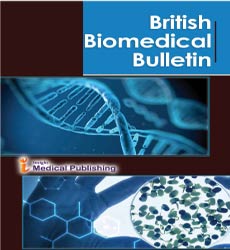ISSN : 2347-5447
British Biomedical Bulletin
Application of Biosafety Materials in Treatment of TB
Dongfang Zhou*
School of Pharmaceutical Sciences, Southern Medical University, Guangzhou, China
- *Corresponding Author:
- Dongfang Zhou
School of Pharmaceutical Sciences, Southern Medical University, Guangzhou, China
E-mail:Dongfang333@gmail.com
Received date: : July 01, 2022, Manuscript No. IPBBB-22-14495; Editor assigned date: : July 15, 2022, PreQC No. IPBBB-22-14495(PQ); Reviewed date:July 21, 2022, QC No IPBBB-22-14495; Revised date:: : July 29, 2022, Manuscript No. IPBBB-22-14495 (R); Published date:Aug 03, 2022, DOI: 10.36648/2347-5447.10.4.1
Citation: Zhou D (2022) Application of Biosafety Materials in Treatment of TB. Br Biomed Bull Vol. 10 Iss No.4:001.
Description
Tuberculosis (TB) is among the deadliest infectious diseases worldwide. Although the existing antituberculosis (anti-TB) drugs remain to be effective, the administration of these complex anti-TB drug combinations with obvious toxicity often leads to patients’ nonadherence. This may contribute toward the emergence of drug-resistant strains as well as lead to treatment failure and relapse. Therefore, in the past half century, the main focus of anti-TB drug research was to reduce the frequency of administration and toxicity and improve patients’ compliance and drug sensitivity. Following these principles, the development of engineered biosafety materials is one of the most effective and promising methods in resolving these challenges. Compared with traditional drugs, biosafety materials provide a viable platform for treating TB, which are beneficial in reducing the frequency of drug administration and systemic toxicity, improving patients’ compliance and drug sensitivity, and enhancing drug targeting. In this review, we summarized the application of biosafety materials in treatment of TB in recent years and discussed the challenges faced when developing a safe, more effective and economical pharmacotherapy against TB.
Multidrug-Resistant TB (MDR-TB) Strains
Biosafety is associated with human health. Many pathogenic microorganisms are threats to human health, such as the recent coronavirus disease 2019 (COVID-19) and the ancient Mycobacterium. For example, tuberculosis (TB) is a highly contagious respiratory disease caused by M. tuberculosis (M.tb). It is the second most fatal infectious disease. About 2 billion people worldwide were infected with M.tb, accounting for 30% of the global population. In 2019, approximately 10 million people had TB and 1.4 million deaths were recorded. These figures have been declining slowly in recent years. Nevertheless, with the increase in drug-resistant strains among patients with TB, especially Multidrug-Resistant TB (MDR-TB) strains, TB remains to be one of the major challenges in global biosafety and health. Breathing in droplets containing M.tb results in the spread of TB. These droplets are usually produced by patients with active diseases and spread when they cough, sneeze, and talk. The droplets usually settle in the lungs, and the microorganisms within them remain in a latent state once they enter the lungs. When the host’s immune system becomes weak, they are reactivated and cause pulmonary or even extra pulmonary TB.
Development of Engineered Biosafety Materials
Generally, TB can be cured and prevented, with approximately 85% of patients being successfully treated by a multidrug combination regimen for 6–9 months. Currently, there are four first-line drugs for TB treatment, including Rifampicin (RIF), Isoniazid (INH), Pyrazinamide (PZA), and Ethambutol (EMB). However, considering the emergence and spread of drug-resistant TB, the treatment period can extend to at least 9–24 months, with the addition of second-line anti-TB drugs such as 4-amino salicylic acid (PAS), Amikacin (AMK), kanamycin (KM), etc. Biosafety materials are produced via the integration of biosafety and material sciences. They can be utilized in the biosafety sub-fields for detection, prevention, and treatment. Although biosafety materials are in the initial stage of development, researchers have taken the lead in applying them to infectious diseases, such as TB or COVID-19. Recently, with the progress of material science, the emergence of biosafety materials provides a viable plan for the treatment of TB. Several biosafety materials have been explored for mono or multidrug delivery in TB treatment. Additionally, compared with traditional anti-TB drugs, biosafety materials have advantages such as high drug loading capacity, long blood circulation time, reduced toxicity, etc. Furthermore, the development of engineered biosafety materials can improve the challenges associated with TB treatment. Therefore, this review summarizes and discusses the recent applications of biosafety materials in TB treatment, aiming to develop new ideas and directions.
Open Access Journals
- Aquaculture & Veterinary Science
- Chemistry & Chemical Sciences
- Clinical Sciences
- Engineering
- General Science
- Genetics & Molecular Biology
- Health Care & Nursing
- Immunology & Microbiology
- Materials Science
- Mathematics & Physics
- Medical Sciences
- Neurology & Psychiatry
- Oncology & Cancer Science
- Pharmaceutical Sciences
